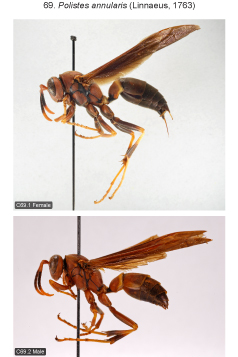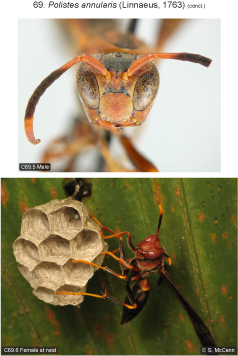
| Home | Table of contents | Keys | Species list | Glossary | Image data | PDF | Cite this article | Feedback | Updates |
Identification Atlas of the Vespidae (Hymenoptera, Aculeata) of the northeastern Nearctic region
CJAI 05, February 19, 2008
doi: 10.3752/cjai.2008.05
Matthias Buck, Stephen A. Marshall, and David K.B. Cheung
Department of Environmental Biology, University of Guelph, Guelph, Ontario, Canada N1G 2W1
Next species | Previous species | Key
69. Polistes annularis (Linnaeus, 1763)
Figs B10.2, 5, 13, 46; C69.1–6.
 |

|
 |
Species recognition. Similar in colouration to P. metricus from which it can be distinguished by the more slender metasomal segment 1, the punctate mesopleuron, often orange flagellomeres VI–X (black above in P. metricus) and yellow apical fascia of tergum 1 (rarely present in P. metricus). The male of P. annularis is unique among northeastern Polistes in showing practically the same colouration as the female, by lacking yellow markings on the clypeus and mesopleuron.
Variation (partly after Richards 1978). Fore wing length 18.5–23.5 mm (♀♀), 17.5–19.5 mm (♂♂). Dark specimens from northern localities have a largely black mesosoma with ferruginous areas on pronotum, margins of scutellum, ferruginous pair of stripes on scutum and spot on upper mesopleuron. Southern specimens have a largely ferruginous mesosoma with black area in front of pronotal carina, black hind margin of scutum, pleural sutures and black central groove of propodeum. Metasoma mainly black, tergum 1 partly to mostly ferruginous, tergum 2 sometimes with pair of ferruginous spots. Yellow markings very restricted, in male usually present along inner eye margin below eye emargination and, rarely, very narrow clypeal margin, both sexes on propodeal valvula, sometimes also on pronotal keel and metanotum along anterior margin, rarely with traces of propodeal stripes (well developed in two males examined). The legs vary from largely black to largely ferruginous (excluding yellow apices of femora, bases of tibiae and tarsi).
Distribution. Not recorded from Canada. Eastern U.S.: MA (probably adventive), NY, PA, OH south to FL, west to SD, NE, KS, OK and TX (Richards 1978).
Biology. Nests attached to twigs and branches of shrubs and trees, also in sheltered places on buildings. Preys on a great variety of caterpillars with records from the following families: Arctiidae, Saturniidae, Geometridae, Limacodidae, Lymantriidae, Notodontidae, Nymphalidae, Sphingidae, Erebidae, Noctuidae, Amphisbatidae and Elachistidae (Krombein 1979).
Next species | Previous species | Key
| Home | Table of contents | Keys | Species list | Glossary | Image data | PDF | Cite this article | Feedback | Updates |
